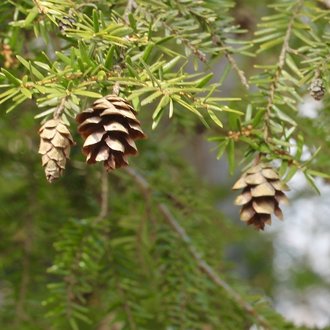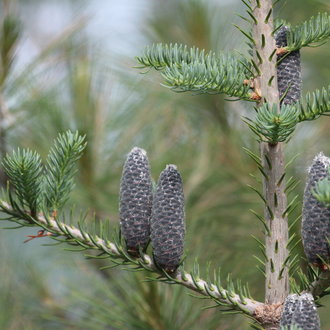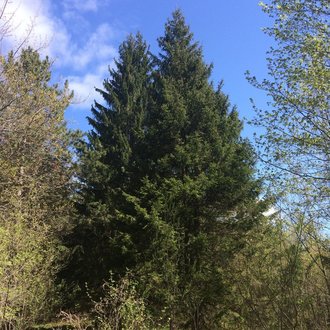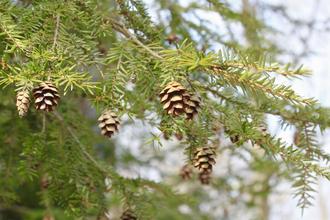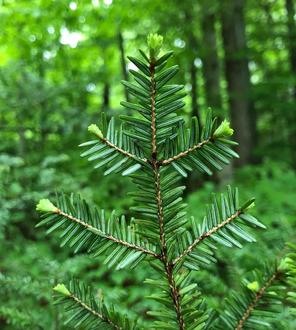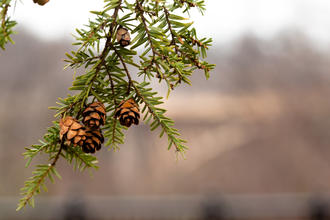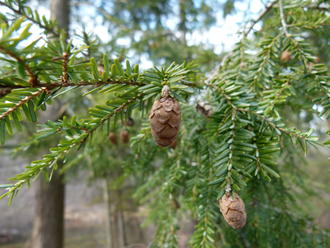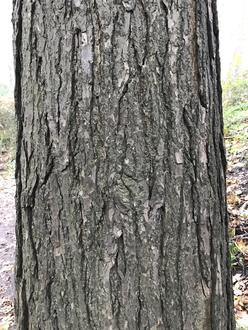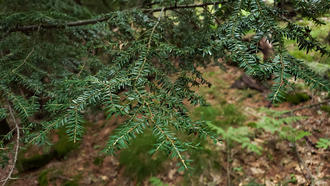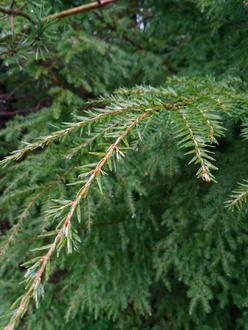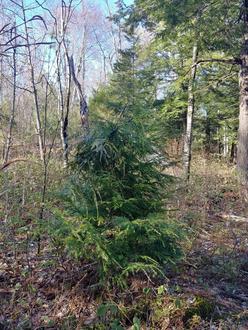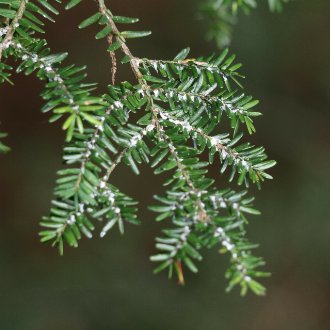Eastern Hemlock (Tsuga canadensis (L.) Carrière)
Also known as Canadian hemlock, eastern hemlock-spruce.
↑Summary
A large, shade-tolerant evergreen conifer native to the Appalacians and northeastern U.S.
↑Range - Expand
| Legend | Color |
| Native | |
| Native or Not Present | |
| Native or Introduced or Not Present | |
| Introduced | |
| Introduced or Not Present |
This tentative map is based on our own research. It may have limited data on Canada and/or Mexico, and there is some subjectivity in our assignment of plants as introduced vs. expanded. Read more in this blog post.
Although this plant occurs somewhere in each of these regions, it may only occur in a small part of some or all of them.
↑Description & Identification
An evergreen conifer with short, flat, round-tipped needles. Foliage is dense on healthy trees, often somewhat drooping; healthy, mature trees cast some of the densest shade of any conifers. Bark of mature trees has long, vertically-oriented ridges and plates. Root system is shallow and wide-spreading. Often looks feathery in silhouette.
↑Similar Plants
↑Habitat
Found mostly in cool, moist forests, especilaly in climax communities protected from disturbance. Prefers sites that are very moist but also well-drained. Frequently found on rocky and acidic soils, also found on well-drained sites at the margins of swamps.
At the south and west of its range, confined to valleys, ravines, and north- and east- facing slopes that produce the cool, moist environments it requires. In the north, also found on warmer and drier sites.
Fire intolerant, and only found on rocky slopes and other drier sites when protected from fire. Often found growing near seeps on rocky slopes.
↑Life Cycle
Tsuga canadensis is among the most shade-tolerant of all large tree species in most of its range. It is slow-growing and often lives hundreds of years. It is one of the few trees that can gradually grow up into the canopy while suppressed by the shade of other trees.
Seedlings require partial shade to get established. Seedlings often establish on rotting logs, and can also germinate in exposed mineral soil, moss, and well-decomposed leaf litter, but do not establish as easily in thick leaf litter of deciduous trees. Mounds formed by the root systems of former trees are a common site for seedling establishment. Young trees can survive hundreds of years under a closed canopy, even of other shade-tolerant species such as sugar maple, and eventually replace these species.
Seedlings cannot tolerate full sun, but become more tolerant of sunny conditions once they reach 3-5 (0.9-1.5m) in height. Root competition for moisture and nutrients may inhibit growth of young trees more than lack of shade.
Under favorable conditions, trees can start producing seeds as young as 20-30 years of age, but production starts much later on trees suppressed by shade. Trees produce some seeds each year, but produce a large crop every 3-4 years.
The seeds are small and winged, and primarily dispersed by wind. Seeds germinate in the spring, following a period of cold dormancy. Seeds that do not germinate the first year do not usually survive a second winter, and there is no seed banking.
With larger trees, the leaf litter creates an acidic environment that gives it a relative advantage over other, particularly deciduous, tree species.
Trees can continue producing large seed crops as long as 450 years of age, and trees can exceed 800 years of age.
Trees cannot resprout if cut or otherwise top-killed, but can reproduce vegetatively by layering, growing new roots where its foliage touches the ground. Layering is rare in nature, but can occur on otherwise healthy windthrown trees.
↑Faunal Associations
Eastern hemlocks, especially when in dense and old-growth stands, provide excellent habitat for many animals. Nesting warblers, including black-throated blue warbler, black-throated green warbler, and blackburnian warbler, are common in such stands. The species is also important to black bears, which use the cavities in older trees as dens.
The foliage is browsed by white-tailed deer, and in the north, moose, and snowshoe hares, primarily in winter when hardwoods and broadleaf plants, the preferred food source of these species, is unavailable.
The foliage also provides cover and thermal insulation to numerous animals, including larger birds and various mammals.
The seeds are eaten by birds and mammals.
There are numerous native insects, mostly native insects, that eat this tree, including the hemlock borer (Phaenops fulvoguttata). Many of them also eat other conifers.
The Hemlock wooly adelgid (Adelges tsugae) is an insect, introduced from East Asia, often heavily infests these trees, sometimes stressing and killing them. Although this insect occurs through most of this tree's range, it causes more serious problems towards the south of its range.
↑Uses
Tsuga canadensis is widely planted as a landscaping tree, but sometimes with little knowledge of its habitat preferences, leading to plants becoming stressed and dying. It does best in shady areas sheltered from wind, such as the north side of a home in a wooded yard, or in areas where fences or windbreaks of other, more wind-resistant evergreen species block the wind. It often fares best when grown together with others of its species.
It is one of the few conifers that makes a good hedge in a partly-shaded area; it resprouts well after regular pruning, and the dense, fine-textured foliage creates a lush, opaque look.
It is not suitable for sites exposed to wind or full sun, and thus makes a poor street tree.
↑Related Plants
Several different Tsuga species are found in North America. In the southern Appalachians, this species overlaps with Carolina hemlock (Tsuga caroliniana).
On the west coast, two species, western hemlock (Tsuga heterophylla), and mountain hemlock (Tsuga mertensiana), are found, but do not overlap with this species in range.
↑Notes
Hemlocks share energy and nutrients between individuals through a network of roots and mychorrizal fungi; if a tree is cut down, it will not resprout, but if supplied with energy from other healthy trees, it may stay alive for years, and its stump and root system may even continue to grow, with its root system supplying the other trees.
↑Links & External Resources
• Eastern Hemlock | Fire Effects Information System (FEIS) (About This Site)
• Tsuga canadensis (Eastern Hemlock) | Illinois Wildflowers (About This Site)
• Tsuga canadensis (Eastern Hemlock) | USDA PLANTS Database (About This Site)
• Tsuga canadensis | Go Botany (About This Site)
• Eastern Hemlock | iNaturalist (About This Site)
• Tsuga canadensis (Canadian Hemlock) | Missouri Botanical Garden Plant Finder (About This Site)
• Eastern Hemlock | Virginia Tech Dendrology Factsheets (About This Site)
• Eastern Hemlock | Silvics of North America (About This Site)
• Tsuga canadensis | Biota of North America Project (BONAP) (About This Site)
• Tsuga canadensis | NatureServe Explorer (About This Site)
• Tsuga canadensis | Flora of North America (About This Site)
• Eastern Hemlock | Maryland Biodiversity Project (About This Site)
• Tsuga canadensis (L.) Carriere (Eastern Hemlock, Canada Hemlock) | Digital Atlas of the Virginia Flora (About This Site)



